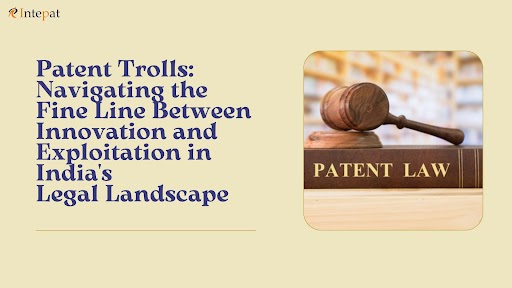Introduction
Patent trolls are entities that do not actively develop their inventions but instead acquire patent rights for obvious inventions to prevent others from working on them or to collect licensing fees. They exploit legal loopholes to generate revenue without ever producing the patented invention, often by threatening lawsuits against other entities that independently develop similar inventions. This practice hinders innovation, as companies are forced to divert resources from research and development into costly legal disputes and licensing arrangements to avoid litigation from patent trolls.
The Dual Impact of Patent Trolls: Both Positive and Negative Contributions
While the term “patent trolls” is often seen in a negative light, they do have some positive contributions to the field of science and technology. Large firms sometimes monopolize obvious inventions, and in such cases, patent trolls can help small businesses fight back. Patent trolls acquire patents from smaller entities and use their resources to challenge patent infringements committed by larger corporations.
For instance, big tech companies like Apple and Google often dominate certain technological fields, making it difficult for small inventors—who could be students or professors—to defend their patents. Without adequate resources, these inventors might not receive fair compensation for their innovations. Patent trolls, in these cases, act as intermediaries, purchasing patents and using their legal resources to sue large firms. In a way, patent trolls serve a purpose, much like lawyers. While they are often disliked, their role can sometimes provide justice—although their actions are frequently seen as exploitative.
On the flip side, the negative effects of patent trolls are significant. They often deter innovation by stopping others from pursuing inventions that may only have slight similarities to their patents. Their activities can also create economic harm, leading to increased operational costs, settlements, and damages for companies, which reduces competitiveness and may result in job losses. The lawsuits filed by patent trolls often affect not only the targeted company but also its peers, causing financial strain across industries. Furthermore, the rise of patent troll litigation clogs the legal system, diverting judicial resources from legitimate cases and causing delays in resolving genuine legal disputes.
Patent trolls in IT industry
Patent trolls are relevant in almost all the industries of science and innovation, but a special mention needs to be made for the patent trolls in the IT industry as it is evident that patent trolls mostly operate in the information technology sector. PAE’s are mostly common in IT Industry, as software patents usually cover broad and vaguely defined concepts. This vagueness makes it easier for patent trolls to assert patents against a wide range of software products and technologies. Many software patents have overlapping claims, which can make it challenging for software developers to avoid potential infringement. Another big reason why patent trolls are so common in the IT industry is because the computer programs are evolving at a fast pace, due to which something which looks unique and new today may become vague and obvious tomorrow, which makes it easier for patent trolls to find their prey for their infringement action.
Legal Measures Against Patent Trolls in India
India’s legal framework includes provisions within the Patents Act of 1970 that discourage patent trolling. Although there are no stringent regulations specifically targeting patent trolls, certain measures make it challenging for Patent Assertion Entities (PAEs) to thrive in India. For example, the Patent Amendment Act of 2005 excludes software from patent protection, making it difficult for trolls to operate in the software sector. Instead, software is protected under copyright law, preventing trolls from extorting fees for computer programs or software from companies.
India’s patent laws are structured in a way that many legal experts believe could serve as a model for other countries, such as the USA and the UK, in dealing with patent trolls.
Post-Grant Opposition
Under Section 25(2) of the Patents Act, any interested party can file a post-grant opposition within 12 months of a patent being granted, based on the grounds specified in the Act. This provision makes it harder for trolls to secure patents for ambiguous, obvious, or non-novel inventions, addressing the root cause of patent trolling. Given that patent offices don’t always thoroughly evaluate the obviousness or novelty of patents during filing, this provision allows interested parties to monitor newly granted patents and challenge them within a 12-month period.
Section 115 of the Patents Act
Section 115 permits the appointment of scientific advisors during patent trials. These advisors assist the court in identifying dubious patents, allowing the court to revoke them. This provision plays a vital role in protecting against patent trolls by ensuring that questionable patents are thoroughly reviewed and potentially invalidated. A notable case exemplifying the legal framework’s effectiveness is Spice and Samsung vs. Somasundar Ramkumar. The case involved a patent related to mobile phones with multiple SIM cards assigned to different communication networks. Revocation was sought under Section 64(1) of the Patents Act, 1970. The Intellectual Property Appellate Board (IPAB) ruled that the invention was anticipated by prior art and that amendments made during the patent application process extended the scope of the disclosed matter, violating Section 59. The applicants also demonstrated the obviousness of the respondent’s patent through various prior art references.
Compulsory Licensing: A Defence against Patent Trolls
Section 92 of the Patents Act provides for compulsory licensing, a mechanism aimed at ensuring that patents serve the public good. If a patented invention is not yielding results or benefiting the public, the government may allow compulsory licensing after a period of three years from the date of the patent’s issuance. Essentially, this provision mandates that patentees must actively work on their inventions; failure to do so opens the door for others to apply for a compulsory license. This regulation acts as a safeguard against patent trolls, who often acquire patents without any intention of developing them, using the patent merely to harass small firms for financial gain.
The intent behind compulsory licensing is clear: it ensures that patents contribute to technological advancement and public welfare, rather than becoming tools for exploitation. Patent trolls, who typically do not utilize their patents for innovation, are thus discouraged from acquiring patents purely for monetary gain through lawsuits. By requiring the patentee to work on their invention, Section 92 ensures that patents cannot be hoarded for litigation purposes alone.
However, this provision has drawn some criticism. Critics argue that the three-year period before a compulsory license can be sought gives patent trolls sufficient time to acquire patents and initiate lawsuits against companies. While the mechanism aims to reprimand trolls for not utilizing their patents, there remains a window during which they can engage in litigation without actually working on their inventions.
Despite its existence, the use of compulsory licensing in India has been rare. It has only been granted once since the enactment of the Patents Act, in the landmark case of Bayer Corporation vs. Natco Pharma Ltd. (2013), where Natco was granted a compulsory license to produce a cancer drug that Bayer had failed to make accessible to the public.
Section 13(4) of the Patents Act: No Presumption of Validity
Another provision that discourages patent trolls is Section 13(4), which states that the issuance of a patent does not guarantee its validity. Unlike in some jurisdictions where patents are presumed valid once granted, the Indian legal framework places the burden of proof on the patentee in cases of patent infringement. This provision creates an additional hurdle for patent trolls, who cannot rely solely on the fact that they hold a patent. They must prove the validity of the patent in any infringement suit, making it more difficult for them to engage in frivolous litigation against small businesses or competitors.
In sum, India’s patent laws, particularly the provisions for compulsory licensing and the lack of presumption of patent validity, offer important defences against patent trolls. These legal measures ensure that patents are used for genuine innovation and public benefit rather than as tools for exploitation by entities seeking to profit without contributing to technological progress.
Conclusion
Every coin has two sides, and the same applies to patent trolls. While they may often appear to be nothing more than money-hungry entities seeking to extort firms, there are instances where patent trolls have teamed up with small businesses to assist them in winning patent infringement cases against large corporations like Google and Microsoft.
Though patent trolls primarily have a negative effect on innovation and the economy, they can also serve as a source of motivation for inventors, encouraging them to enhance their inventions and stand firm in their pursuits. While patent trolls can exploit the system for financial gain rather than fostering genuine advancements, addressing this issue requires a nuanced approach that considers the positive aspects of their existence.
By developing legal frameworks that mitigate the negative impacts of patent trolling while allowing for their potential supportive role, we can create a more balanced environment. This will help ensure that innovation remains at the forefront, allowing inventors and small businesses to thrive without the looming threat of exploitation.
Written by Debapom, an assessment intern at Intepat IP.




